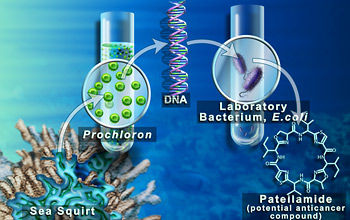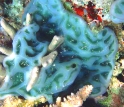News Release 05-073
Little Microbe Inside Sea Squirt Makes Big Splash
Bacterial genome sheds light on synthesizing cancer-fighting compounds

Scientists discovered Prochloron didemnii produces patellamides.
May 9, 2005
This material is available primarily for archival purposes. Telephone numbers or other contact information may be out of date; please see current contact information at media contacts.
Sea squirts around the world are breathing a sigh of relief, as they no longer run the risk of being harvested for their natural disease-fighting substances. Scientists recently discovered that the bacterium Prochloron didemnii, which lives symbiotically inside the sea squirt, actually produces the desired patellamides, compounds that may one day be used in cancer treatment.
Despite decades of attempts, scientists could not successfully cultivate Prochloron in the laboratory once the bacterium was isolated from the sea squirt. Because samples of Prochloron were easily contaminated with remnants of life inside its animal home, scientists couldn't tell if the bacterium or the sea squirt produced the sought-after patellamides, until now.
By searching for patellamide synthesis instructions in genomic sequences, scientists found the bacterium indeed has the necessary genes to produce these potentially important biochemicals, solving the source mystery. Knowing which genes Prochloron used for patellamide production also allowed researchers to synthesize the potentially important compounds in the lab using a so-called laboratory workhorse, the bacterium E. coli.
Scientists from The Institute for Genomic Research (TIGR), the University of Utah and the University of California, San Diego, report findings in this week's online edition of the Proceedings of the National Academy of Sciences.
"This project revealed detailed information about the metabolic capabilities of Prochloron, details that proved to be difficult to determine by other means, " said Patrick Dennis, manager for Prochloron genome sequencing at the National Science Foundation, which funded the study. "Furthermore, " he added, "by producing patellamides in the lab, the team demonstrated an important proof of principle for the biosynthesis of naturally occurring marine products."
For a complete story, see the news release at www.tigr.org.
-NSF-
-
Sea squirts contain a microbe that produces potential cancer-fighting chemicals.
Credit and Larger Version
Media Contacts
Richard (Randy) Vines, NSF, (703) 292-7963, email: rvines@nsf.gov
Program Contacts
Patrick P. Dennis, NSF, (703) 292-7145, email: pdennis@nsf.gov
The U.S. National Science Foundation propels the nation forward by advancing fundamental research in all fields of science and engineering. NSF supports research and people by providing facilities, instruments and funding to support their ingenuity and sustain the U.S. as a global leader in research and innovation. With a fiscal year 2023 budget of $9.5 billion, NSF funds reach all 50 states through grants to nearly 2,000 colleges, universities and institutions. Each year, NSF receives more than 40,000 competitive proposals and makes about 11,000 new awards. Those awards include support for cooperative research with industry, Arctic and Antarctic research and operations, and U.S. participation in international scientific efforts.
Connect with us online
NSF website: nsf.gov
NSF News: nsf.gov/news
For News Media: nsf.gov/news/newsroom
Statistics: nsf.gov/statistics/
Awards database: nsf.gov/awardsearch/
Follow us on social
Twitter: twitter.com/NSF
Facebook: facebook.com/US.NSF
Instagram: instagram.com/nsfgov



